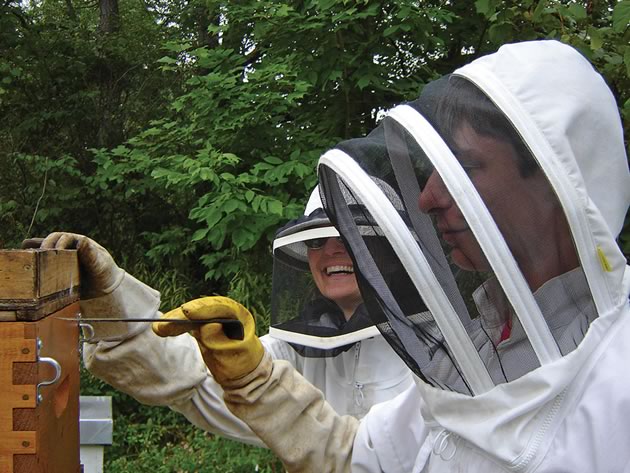Adventures in Beekeeping
Anthony Jenkins on how he dove into beekeeping head first – and emerged (relatively) unscathed.
I’m a voyeur, environmentalist, labourer, nursemaid, murderer, victim and thief. I keep bees.
The summer before last, I noticed an announcement for a big bee confab at the University of Guelph called the Eastern Apiculture Society Annual Conference. Public welcome. We have land in Mono and I’m drawn to the unusual like bees to apple blossoms, so I signed up for the one-day introductory course. The hands-on component worried me though.
The Guelph bee people seemed like you or me – a smattering of nutters, bores and the overly intense, but also plenty of average Joes who outnumbered the average Janes about eight to one. There is a lot of heavy lifting in bees, I’d learn.
The morning classroom session was informative – your standard bee makes one-eighth of an ounce of honey in her (the workforce is exclusively female) lifetime and that lifetime is brief. Six weeks. She essentially works herself to death. “Death” was on the agenda after coffee break. Well, “Opening a Hive” and “Bee Handling” were on the agenda, but my own horrible death from an orgy of stings was on my mind.
Out in the “bee yard” novices were given pith helmets and goofy mesh hoods which we laced up oddly under our arms and around our bodies. They were easy to put on backwards – not that this happened to me – and seemed nowhere near adequate protection against the 50,000-plus bees said to lurk in each hive. A complete lack of protective gloves, jacket or pants seemed even more inadequate. I felt my best protection was a good pair of running shoes.
Hives – stacks of pastel-coloured wooden boxes – were broken into and entered. “Slowly” and “calmly” were the instructor’s watchwords and “frames” of honeycomb liberally covered in bees were passed around.
Gingerly. With index finger and thumb, I gripped the corners of each wooden rectangle. Heavy, seething and initially terrifying rectangles. Bees crawled over my bare hands and arms. They tickled – not that I was laughing. “What happens if I drop this?” I asked the instructor. “Don’t!” was his expert advice.
I learned a lot on the course, but the primary lesson was that I wasn’t afraid of bees. Great masses of bees. I could consider this hobby! I was given The Backyard Beekeeper for Christmas and read it avidly over the winter. It was dense with information. I was just dense. There was so much to know. The book advised joining a local beekeepers group.
I thus found myself in the rustic boardroom of an Amaranth agricultural concern attending a monthly meeting of the Dufferin County Beekeepers’ Association. I appealed to the Grand Exalted Drone (or whatever he was called) for an introduction to a beekeeper near my home and was introduced to Wayne Holmes from Primrose.
Wayne is my age, has been “in bees” for 40 years and runs 100 hives. He had the laid-back wisdom of Solomon and the steely patience of Job. I needed the former. He’d need the latter. He became my mentor.
I was invited to his bee yard where I opened hives, kicked the tires, got familiar. Wayne sussed the entry level I needed. Rather than begin with a small starter set (a “nuc,” for nucleus colony), he suggested I jump into the deep end with a full, thriving colony that I wouldn’t have to nurture and grow. In effect, I wouldn’t be adopting an infant, I’d become Dad to a feisty 27-year-old. Who was I to argue?
I bought two “brood boxes” (nursery chambers where the queen lays eggs and new generations emerge) and several “supers” (honey storage boxes that sit atop the nurseries). The price included all bees in residence – workers, drones and one young and healthy queen. I installed the hive well away from my home. A Usain Bolt dash-and-a-half away, I estimated. I had a living, working hive on site. I was a beekeeper!
I began frequenting bee supply places, becoming fluent in bee jargon. I bought hive tools, a screened bottom board, a queen excluder and other esoteric paraphernalia. I got the best damn bee suit money could buy. I didn’t want bee-resistant, I wanted bee-proof – triple-layer, ventilated, with zippers, Velcro and written “no-sting” guarantees in six languages, including bee. I slipped on the suit and looked like an idiot. A happy, well-protected idiot.
There seems an unfathomable pride among some veteran beekeepers about being lightly protected and not being bothered by stings. At the place I purchased my bee gloves – thick, up-to-the-elbow gauntlets – an arrogant expert scoffed. He went about beekeeping bare-handed for the delicacy of feel. Why he’d been stung six times that morning! A man! Well pardon my dainty little pain threshold! I don’t want to get stung. Ever! If dressing like a weak-kneed bee sissy is the price, I’ll pay it.
Photos of me in full bee regalia had my grown daughters in stitches. And concerned. They consider me, completely without justification, a pratfalling klutz and envisioned me racing around the yard Benny Hill-like, shrieking and trailing a swarm of angry bees.
The first time I opened my hive to check that the queen was healthy and laying and the supers were filling, I was nervous. Very nervous. Hitherto, bees had been theoretical, or I’d had backup. Now I was alone and outnumbered 50,000 to one. My bee-proof suit was proving bee-proof, but it was hot inside. Very hot. Hives are best opened on warm, sunny days when the bees are content and many are away foraging. On cool, grey or rainy days they are hive-bound and resent visitors.
Mid-morning in May, in my sauna of a suit, I wedged a hive tool between supers and pried them apart with a sticky crack. Honey residue and “propolis” (a brittle glue bees manufacture to seal cracks and crevices) had welded the layers together. With effort I lifted away the uppermost box. Inside the nine-frame super was a thick, moving carpet of bees, egged on by a roaring buzz from their sisters in the bowels of the hive below. The bees were both curious (some) and angry (many), and began erupting from between the frames.
“Smokers” (archaic bellows contraptions filled with burning tinder) are how beekeepers deal with this. Smoke, puffed across an opening, masks the queen’s alarm pheromones and signals “Fire!” which sends workers scurrying below to eat and save honey. At first I couldn’t keep the smoker lit. Soon, having overcompensated, I was gagging on dense clouds of acrid smoke – choking, sweating, swearing and grunting as I wrestled with supers heavy with bees, comb and honey.
I dropped one. Jarred, the curious bees were now angry and the angry bees were now enraged. I had honey down my suit, a throbbing pain in my foot where the super had landed, and I’d overturned the smoker, threatening a grass fire. I came to the slow realization that my new hobby was complicated, laborious and dangerous. Welcome to beekeeping!
Wayne’s advice had been “Go slow,” and when things go wrong, “Go slower.” Trying to ignore the battalions of angry bees on and all around me, I methodically checked all the boxes in turn, seeing that the hive was healthy and well-ordered. Blinded by sweat and unsure, I never could locate the queen (slightly longer and more tapered than her blue-collar sisters), but there were new eggs and larvae in the brood box and honey to feed them was stored in the comb. Barring the odd dropped super, all was well in my bees’ world.
The whole debacle had taken 40 minutes. It felt much longer. I made a sweat-drenched, exhausted and relieved retreat. My bee manual informed me bees rarely follow intruders more than 30 metres from the hive. Most bees had read the manual, but not all. A few hard cases continued their angry assault on the mesh protecting my head and face the full way back to the house.
I sat on the deck, an immobile, one-man sauna until they lost interest and left. I then removed the bee suit with nervous deliberation in case sneaks lurked in its folds, savouring revenge. After a sigh, a shower and a beer, it occurred to me that a six-buck supermarket squeeze bottle was a much, much easier way to get honey.
Over the summer my bees thrived – on dandelions, then apple blossoms, wildflowers, milkweed and goldenrod – and I learned, mostly from mistakes. I no longer kept the chisel-like hive tool in my suit’s hip pocket. (It has a tendency to disembowel when you bend.) The elaborately perforated cedar disk I constructed as a platform for drinking bees quickly sank in its water bucket. (My bees preferred the libations of the neighbour’s ornamental pond.) I made sure zippers were done all the way up. (It is difficult to outrun a bee when it is inside your suit.) And before mounting a wagon hoisting a full super overhead, I now chock its wheels. (Wagons tends to roll, spilling you heavily into the weeds.)
I got stung. Going out my front door! I was actually relieved when I discovered it was a wasp, not one of mine being naughty. A week later I got stung again. One of mine this time. My mistake. I’d gone back to the hive, ever so briefly unprotected, to retrieve something. She nailed me on the hand. I’d been stung as a child, tears, but no problem. Now, in my dotage, I had a problem. My hand swelled into a catcher’s mitt – big, hot, red and itchy. I’m allergic!
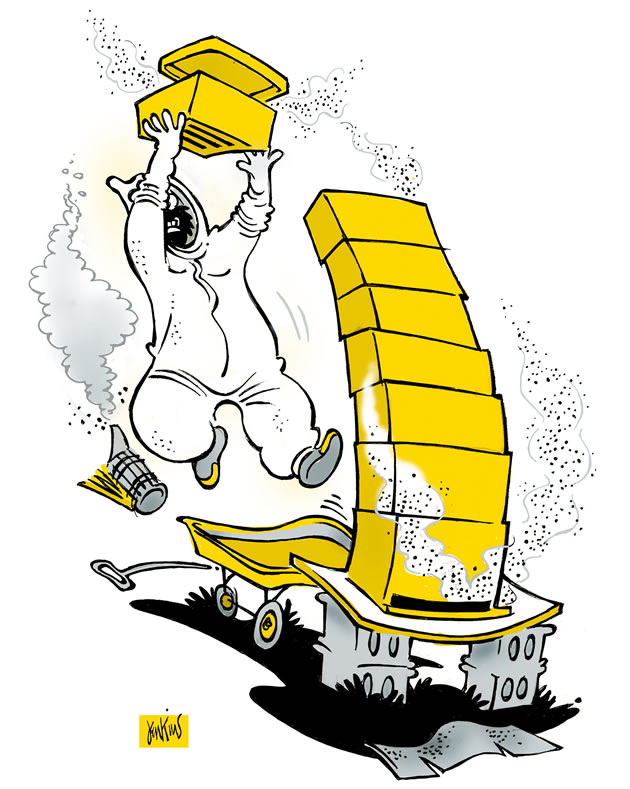
My success began to worry me. My bees were making honey at a prodigious rate. If they filled every super and felt crowded, they might “swarm” – half the hive decamping for parts unknown, following the old queen, leaving a now uncrowded hive to a new virgin queen. An ambitious beekeeper will anticipate swarming and split a crowded colony into a second hive. I’m not that ambitious beekeeper, looking for twice the bees and work. Status quo, with honey and without stings, is just peachy with me.
But my bees wouldn’t listen! They were busy as, well, bees! Take away supers to limit storage and they might swarm. Add supers to increase space and they’d up production to fill it. Conundrum. I added extra supers and soon had The Leaning Tower of Honey as the weight of my monumental hive began to warp the particleboard platform on which I had foolishly sited it.
Twice in the season, mid then late summer, I “extracted” (stole). Wayne may have helped – a lot. I bought more stuff: a manual honey extractor, uncapping tank, electric hot knife, plastic pails with “honey gates,” and was prepared for a mess and honey.
Frames full of capped honey were decapitated with a hot knife with which Wayne had a virtuoso’s touch. Me, less so, although I still have all my fingers. The oozing frames were then suspended in wire baskets in the “extractor” (think polished garbage can on legs) and spun by hand crank until most of the honey flew out. Or most of the skin on my palm came off.
Honey collected in the extractor was drained out a spigot, through a double strainer and into jars. It can be messy. I was sticky, but elated. I extracted 26 jars the first time, over 50 by summer’s end! This wildly exceeded my expectations and the honey tasted different and much better than store-bought stuff with all the flavour and goodness pasteurized out.
I patted myself on the back once my palms regrew skin. I swelled with inordinate pride when I held that first jar of glowing, amber honey. My honey. Everyone I knew got honey whether they wanted it or not, even the diabetics. Compliments of me and my girls.
As winter approached I hoped I’d left my bees enough honey to sustain their reducing numbers. Drones, males whose job description is “procreate then loaf” (I wish!), were driven from the hive to their death by the females, many of whom will themselves die over winter. The hardiest reach spring to tend newly laid larvae and renew the colony – if I’m lucky and proved competent at winter prep.
I festooned the hive with pads and powders to kill mites and diseases, reduced the entrance opening against mice and varmints, wrapped the hive in thick black insulation and topped the lot with a large rock against more sizeable predators. Good night, girls. See you in the spring!
My first year in bees: I spent about $1,500, nurtured 50,000 bees. I was stung three times, perspired 28 quarts, extracted and bottled six dozen jars of honey, bemused my friends, amused my daughters, taxed my mentor, served my environment and impressed myself. I had fun!
My bees and I are doing it all again this year.
Related Stories
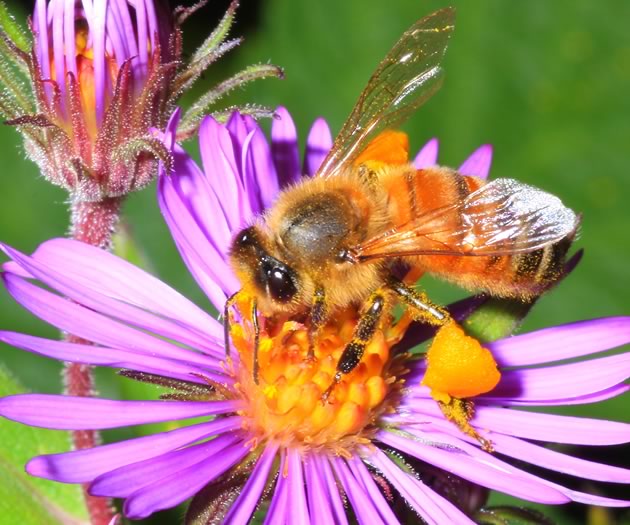
Honeybees
Sep 16, 2015 | | Notes from the WildWe need to learn more about honeybees and other pollinators so we can contribute intelligently to the conversation about their health and well-being.
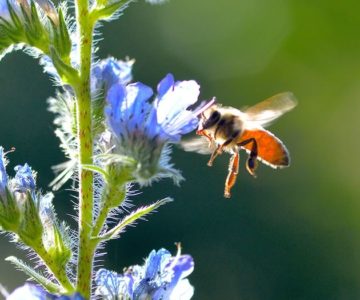
Meet Mulmur’s New Beekeepers
Jun 21, 2017 | | FarmingHow the Heritage Bee Company is boosting the honeybee population in Headwaters and inspiring newbie beekeepers.
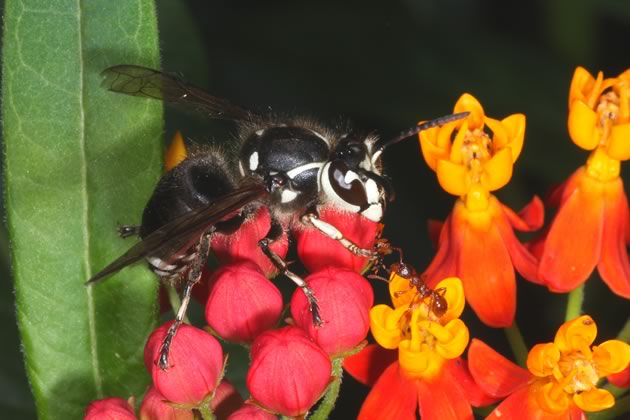
Pollinator Friendly Gardens
Aug 28, 2013 | | Notes from the WildWhen I walk into my yard I am greeted by a gloriously diverse menagerie of tiny winged creatures.



